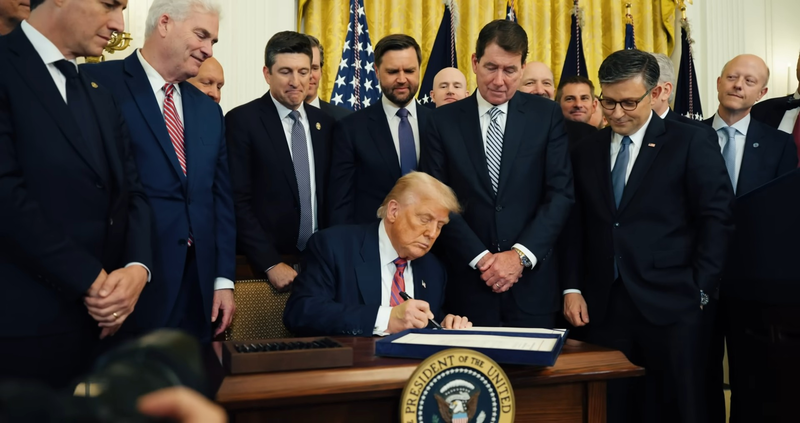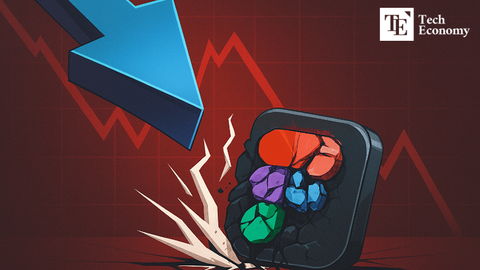U.S. House Passes ‘CBDC Ban Act’; Moves to Strengthen Dollar Hegemony Through Stablecoins
Input
Changed
Trump Signs Stablecoin Legalization Bill China’s CBDC Adoption Permanently Prohibited U.S.-China Diverge in Strategy, Enter Full-Scale Currency Hegemony Rivalry

Last week, the U.S. House of Representatives passed major legislation related to digital assets, including a bill that entirely bans the issuance of a central bank digital currency (CBDC). This reflects President Trump’s policy direction. Since his presidential campaign last year, Trump has expressed concern that CBDCs could enable surveillance of financial activities by tracking the flow of money for individuals and companies. He has called for a restructuring of the digital asset system. With the passage of this legislation, the United States made it clear that it intends to strengthen stablecoins as an alternative to CBDCs and a means of maintaining dollar hegemony in the digital era.
U.S. House Passes Digital Asset Bills During ‘Crypto Week’
On July 21 (local time), political circles reported that the House of Representatives passed three major bills during ‘Crypto Week’, which focused on digital asset discussions: the Stablecoin Regulation Act (GENIUS Act), the Digital Asset Market Structure Act (CLARITY Act), and the CBDC Ban Act (Anti-CBDC Act). Despite multiple delays due to opposition from hardline conservatives within the Republican Party, the bills passed with 308 votes in favor and 122 against. The following day, on the 18th, President Trump signed the so-called GENIUS Act at the White House.
Although the signature process for the Digital Asset Market Structure Act and the CBDC Ban Act remains pending, the passage of all three bills deliberated during Crypto Week is seen as resolving much of the regulatory uncertainty surrounding digital assets. As a result, investment sentiment toward major cryptocurrencies like Bitcoin and related stocks such as Coinbase is expected to improve, potentially leading to increased capital inflows into the crypto market. On July 14, when legislative discussions intensified, Bitcoin hit an all-time high of $122,944 during intraday trading and is currently fluctuating between $118,000 and $120,000.
In addition to the legalization of stablecoins, another core principle of this Crypto Week was the total prohibition of CBDCs. The CBDC Ban Act prohibits the Federal Reserve from issuing, distributing, or operating a CBDC. CBDCs, as digital forms of central bank money, allow for real-time tracking of all financial flows and have raised concerns about being misused as tools for monitoring individual and corporate financial activity. While the Federal Reserve and other major institutions had conducted years of research on implementing a digital dollar system, this legislative decision effectively halts further discussion.
Trump: “CBDC Is a Dangerous Tool for Surveillance”
This shift in CBDC policy began in earnest with Trump’s inauguration. As a candidate, he labeled CBDCs as "government surveillance tools" and "threats to individual freedom," and voiced strong opposition. Shortly after taking office in January, he issued Executive Order 14178, titled “Strengthening American Leadership in Digital Financial Technology,” which banned all research, experimentation, issuance, and recommendations related to CBDCs. This effectively nullified Executive Order 14067, the Biden administration’s 2022 digital asset policy blueprint.
Following the GENIUS Act signing on July 18, President Trump stated during a White House briefing, “CBDCs are dangerous tools that allow the federal government to control citizens’ assets and transactions.” He added, “I have already banned CBDC issuance by executive order, and will soon codify this into law to permanently prohibit it.” He made clear that no future administration would be able to implement a CBDC. “All of this is to protect the American identity—freedom and democracy,” he said. “The United States will never infringe upon its people’s freedom, privacy, or economy with a centrally controlled digital currency.”
Some interpret this move as a strategic policy to expand demand for U.S. Treasury bonds. President Trump’s large-scale tax cut proposals could lead to increased budget deficits and bond issuance. However, the global capital markets are witnessing a ‘Sell America’ trend. A rare phenomenon is occurring in which the value of the dollar is falling despite rising U.S. Treasury yields. For example, when President Trump announced a 10% universal tariff and country-specific reciprocal tariffs in April, the 10-year Treasury yield rose from 4.13% to 4.41%, but the dollar index dropped by 4.15% during the same period.
In this context, the U.S. is formulating a strategy to nurture stablecoin issuers as new demand sources for Treasury bonds. Stablecoin issuers must hold reserves to maintain the coin’s value, and the U.S. government is guiding them to hold Treasuries instead of dollars. The GENIUS Act outlines reserve requirements including U.S. legal tender, central bank deposits, and U.S. Treasury securities with a remaining maturity of 93 days or less. Currently, the combined Treasury holdings of USDT and USDC—the two dominant stablecoins—total $126 billion.

China Expands Digital Yuan as Part of De-Dollarization Strategy
Experts believe that by legalizing the stablecoin system and banning CBDC adoption, the United States is entering a full-fledged currency hegemony battle with China, which has already implemented a CBDC. Under the leadership of the People’s Bank of China, the country has been piloting one of the world’s most advanced digital yuan systems (DCEP). Starting in 2020 in major cities like Shenzhen, Suzhou, and Beijing, digital yuan payments are now possible in over 200 cities. The electronic wallet app “Digital Yuan (数字人民币)” has amassed hundreds of millions of users and is used in public sector salary payments, public transport, and online shopping.
Moreover, the Chinese government has made it clear that it views the digital yuan not merely as a payment method but as a tool to internationalize the yuan and solidify economic and financial dominance. During the 2022 Beijing Winter Olympics, digital yuan was offered to foreign participants as a payment option. In Hong Kong, the government has enabled the use of digital yuan without the need for a mainland bank account. Amid growing geopolitical tensions, de-dollarization trends are accelerating, and China is expanding yuan-based settlements in Asia, Belt and Road Initiative (BRI) countries, and other emerging markets.
According to SWIFT, the yuan’s share in international payments stood at 2.2% as of July, still far behind the dollar’s 40%. However, if China continues to expand the use of the digital yuan among allied and trading partner countries, it could become a new driver of yuan internationalization. The U.S. is actively seeking to counter this trend. Media outlets such as The Wall Street Journal and Bloomberg have analyzed President Trump’s CBDC ban as a response to concerns that digital currencies could grow into "derivative weapons" challenging the global influence of the dollar.
Meanwhile, while the U.S. and China have launched a digital currency hegemony race, South Korea has yet to establish a clear direction. Although the Bank of Korea has been working to implement a CBDC, attention has shifted to the U.S. model following President Lee Jae-myung’s campaign pledge to issue stablecoins. However, Bank of Korea Governor Rhee Chang-yong has publicly voiced concerns over potential side effects of privately issued stablecoins. Cho Seung-rae, spokesperson for the National Planning Committee, also noted, “Many contentious issues remain, including the issuing entities, licensing methods, and international cooperation,” signaling a cautious stance.





















